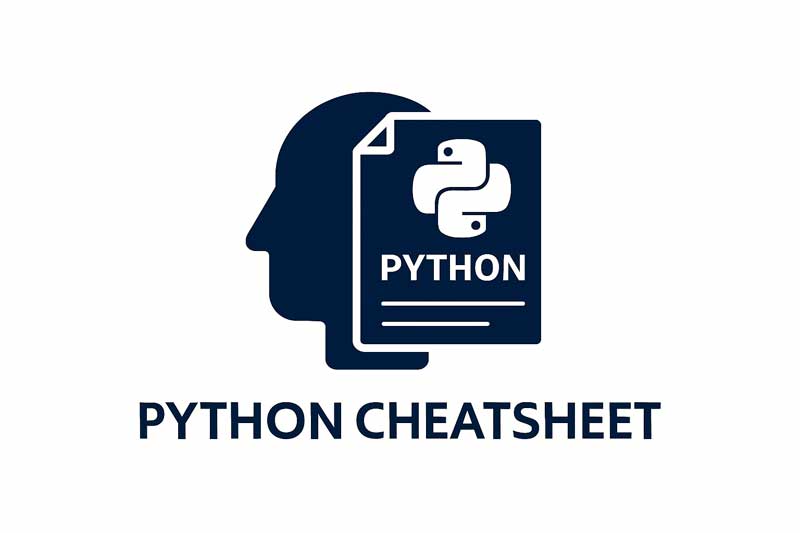This Python Cheat Sheet is your quick reference guide for writing efficient Python code. Whether you’re preparing for coding interviews, building web apps, or automating tasks, this page helps you recall syntax, functions, and examples instantly.
Table of Contents:
Introduction to Python Programming
Python is a high-level, interpreted language famous for its simplicity, readability, and versatility. It supports multiple paradigms like object-oriented, functional, and procedural programming.
Example: Basic Hello World Program
print("Hello, World!")
Output:
Hello, World!
Python Syntax and Variables
Python uses indentation (4 spaces) instead of braces {} for code blocks.
name = "Alice"
age = 25
height = 5.6
is_student = True
print(name, age, height, is_student)
Python Data Types and Type Conversion
| Data Type | Example | Description |
|---|---|---|
int | x = 10 | Integer numbers |
float | x = 10.5 | Decimal numbers |
str | x = "Python" | Text data |
bool | x = True | Boolean |
list | x = [1, 2, 3] | Ordered, mutable sequence |
tuple | x = (1, 2, 3) | Ordered, immutable sequence |
set | x = {1, 2, 3} | Unordered, unique elements |
dict | x = {"name": "Alice", "age": 25} | Key-value pairs |
Type Conversion Example:
x = "123"
y = int(x)
print(y + 10)
Python Operators Reference Table
| Operator Type | Example | Description |
|---|---|---|
| Arithmetic | + - * / % ** // | Add, subtract, multiply, divide, modulus, exponent, floor division |
| Comparison | == != > < >= <= | Compare two values |
| Logical | and, or, not | Boolean operations |
| Assignment | = += -= *= /= | Assign and update values |
| Membership | in, not in | Check presence in sequences |
| Identity | is, is not | Compare object identity |
| Bitwise | `& | ^ ~ << >>` |
Python Conditional Statements
age = 20
if age >= 18:
print("Adult")
elif age > 13:
print("Teenager")
else:
print("Child")
Python Loops and Iteration
For Loop Example
for i in range(5):
print("Number:", i)
While Loop Example
count = 0
while count < 3:
print("Count:", count)
count += 1
Loop Control Statements
break→ exits loopcontinue→ skips iterationpass→ does nothing (placeholder)
Python Functions and Scope
def greet(name="User"):
"""Simple greeting function"""
return f"Hello, {name}!"
print(greet("Alice"))
Lambda Functions
square = lambda x: x * x
print(square(4))
Python Lists, Tuples, and Dictionaries — Data Structures Quick Reference
Lists
fruits = ["apple", "banana", "cherry"]
fruits.append("mango")
print(fruits[1]) # banana
Tuples
colors = ("red", "green", "blue")
print(colors[0])
Dictionaries
student = {"name": "John", "age": 20, "marks": 88}
print(student["name"])
Python String Handling and Formatting
text = "Python Cheat Sheet"
print(text.lower())
print(text.upper())
print(text.replace("Python", "Awesome Python"))
print(f"{text} is easy to learn!")
Python File Handling Examples
# Write to a file
with open("data.txt", "w") as f:
f.write("Learning Python is fun!")
# Read a file
with open("data.txt", "r") as f:
content = f.read()
print(content)
Python Exception Handling
try:
num = int(input("Enter a number: "))
print(10 / num)
except ValueError:
print("Invalid input!")
except ZeroDivisionError:
print("Cannot divide by zero!")
finally:
print("Done.")
Python Classes and Object-Oriented Programming
class Car:
def __init__(self, brand, color):
self.brand = brand
self.color = color
def drive(self):
print(f"{self.brand} is driving...")
car1 = Car("Tesla", "Red")
car1.drive()
Python Modules and Imports
import math
print(math.sqrt(16))
Custom module:
# mymodule.py
def add(a, b):
return a + b
# main.py
from mymodule import add
print(add(5, 7))
Python List Comprehension and Generator Expressions
squares = [x * x for x in range(1, 6)]
print(squares)
even_numbers = (x for x in range(10) if x % 2 == 0)
for num in even_numbers:
print(num)
Python Useful Built-in Functions
| Function | Description |
|---|---|
len() | Returns length |
type() | Returns type |
range() | Generates sequence |
sorted() | Returns sorted list |
sum() | Adds numbers |
max(), min() | Find extremes |
enumerate() | Returns index and value |
zip() | Combines iterables |
map(), filter() | Apply functions to data |
Python Packages and Virtual Environments
pip install requests
pip list
To create a virtual environment:
python -m venv myenv
source myenv/bin/activate # (Linux/Mac)
myenv\Scripts\activate # (Windows)
Python File and Directory Operations
import os
os.mkdir("demo_folder")
os.rename("demo_folder", "new_folder")
print(os.getcwd())
Python Regular Expressions (re module)
import re
text = "Contact: hello@phponline.in"
result = re.search(r"\w+@\w+\.\w+", text)
print(result.group())
Python Cheat Sheet Summary Table
| Topic | Key Syntax | Example |
|---|---|---|
print() | print("Hello") | |
| Input | input() | name = input("Enter name:") |
| Loop | for i in range(n) | for i in range(3): print(i) |
| Function | def name(): | def add(a,b): return a+b |
| List Comprehension | [x*x for x in range(5)] | [1,4,9,16,25] |
| Try-Except | try: ... except: | try: x=1/0 except: print("Error") |
| Class | class Name: | class Car: pass |
Python cheat sheet, Python syntax reference, Python programming examples, Python basics tutorial, Python functions and loops, Python data structures guide, Python file handling, Python OOP, Python shortcuts
Related Internal Resources
- Python Basics Tutorial — start coding in Python
- PHP vs Python Comparison — backend language guide
- Online HTML Editor — test web integration
- Effective Resume Writing — job interview preparation
Frequently Asked Questions (FAQ)
Q1. Is Python beginner-friendly?
Yes. Python is ideal for beginners because of its clean syntax and readability.
Q2. How can I run a Python program?
Save the file as program.py and run python program.py in the terminal.
Q3. What’s the difference between list and tuple?
Lists are mutable (can be changed); tuples are immutable (fixed).
Q4. What is PEP8?
PEP8 is the official Python style guide. It defines code formatting standards.
Q5. How do I comment in Python?
Use # for single-line comments and triple quotes ('''...''') for multi-line.



